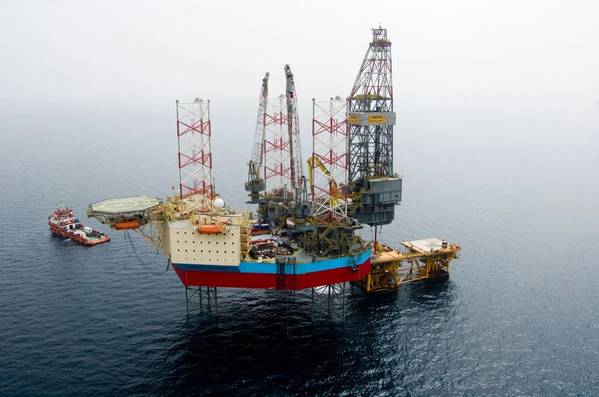
Danish offshore oil and gas drilling company Maersk Drilling is stepping up its efforts to reduce emissions associated with its drilling operations.
It in June joined a consortium whose aim is to develop an offshore storage solution for CO2 captured in Danish onshore facilities.
The plan is to develop of CO2 storage capacity offshore Denmark based on reusing discontinued offshore oil and gas fields for permanent CO2 storage with the capacity to store approximately 3.5 million tons CO2 per year by 2030. (More on that here)
Now, the company is investing into a "net-negative emissions technology" that might offset emissions from its drilling operations further by reducing emissions elsewhere.
Namely, Maersk Drilling said Wednesday it had entered an agreement to invest USD 1m in the California-based company Clean Energy Systems to help develop a new technology called Carbon-Negative Energy.
"The concept builds on proven technology originally developed for the aerospace industry, which is now being deployed in a process that is expected to result in net-negative carbon emissions."
According to the company, full-scale deployment of the Carbon-Negative Energy concept will produce renewable fuel and power, and simultaneously remove greenhouse gases from the atmosphere. The net negative carbon emissions can be converted into carbon credits.
"The agreement between Clean Energy Systems and Maersk Drilling gives Maersk Drilling an option to offset the emissions resulting from drilling for its customers or for the company itself," Maersk Drilling said.
Morten Kelstrup, Chief Operating Officer of Maersk Drilling, explained:“By investing in Clean Energy Systems’ concept, we are helping to bring alive a new technology which can remove CO2 from the atmosphere. We believe the world needs a broad portfolio of technologies and solutions to meet the challenge posed by climate change, and by engaging in this project, we support the development of carbon capture and storage in a way that could allow us to progress towards carbon-neutral drilling.”
Biomass-waste to syngas
The Carbon-Negative Energy concept is based on using biomass waste, available in California due to local weather conditions and an excess of waste from forestry and agriculture, as fuel to produce syngas, from which renewable natural gas and hydrogen is separated for sale.
The biomass is used to fuel the production of a synthesis gas which as the next step is used to produce renewable natural gas, renewable hydrogen and electricity with full capture of associated CO2 emissions.
The resulting products can be fed into the state’s existing energy infrastructure and used to e.g. charge electric cars, while the captured CO2 can be stored safely and permanently.
"The resulting hydrogen-depleted syngas will be used to produce electricity with full capture of associated CO2 emissions. By using fuel that consumes CO2 over its lifetime, combined with safe and permanent CO2 storage, the process results in net-negative emissions, effectively removing CO2 from the atmosphere," Maersk Drilling says.
Clean Energy Systems estimates that its first project will be able to capture and store 300,000 tons of CO2 per year, with operations expected to begin in late 2022.
“We are very excited to work with Maersk Drilling on these innovative projects to remove CO2 from the atmosphere in the near term, while producing renewable transportation fuels. Carbon-Negative Energy can be a key contributor to helping companies meet their net carbon zero goals, and these projects can be replicated in Europe and other markets,” says Keith Pronske, President and CEO of Clean Energy Systems.
Power from Shore, Hybrid rigs
"For Maersk Drilling, this is one of several opportunities being pursued in order to help the company’s customers move towards carbon-neutral drilling," Maersk Drilling said of the investment in Carbon-Negative Energy-
As for Maersk Drilling's other efforts to tackle emissions, back in 2017, the company's Maersk Invincible drilling unit became the world's first harsh environment jack-up drilling rig to operate entirely on shore-power, the Norwegian hydropower, to be precise.
This was made possible because the jack-up rig was positioned at the AkerBP operated Valhall Complex in the central North Sea, a complex that receives its electricity from the shore, via a 294 km cable from Lista on the coast of Norway.
Apart from reducing emissions from the rig, the shore-power solutions also reduced cost and time for maintenance on diesel engines and generators, and provided a better working environment in the engine rooms. Furthermore, Maersk at the time said the deck would be be easier to keep clean since there wouldn't be soot from the exhausts.
Further, Maersk Drilling is upgrading its Maersk Intrepid drilling rig turn it into the first hybrid, low-emission jack-up rig.
These upgrades combine the use of hybrid power with low levels of NOx emissions, adding data intelligence to further reduce energy consumption and CO2 emissions. The project is supported by a grant from the Norwegian NOx Fund, and by Equinor’s decision to introduce compensation formats to stimulate emission reductions.


